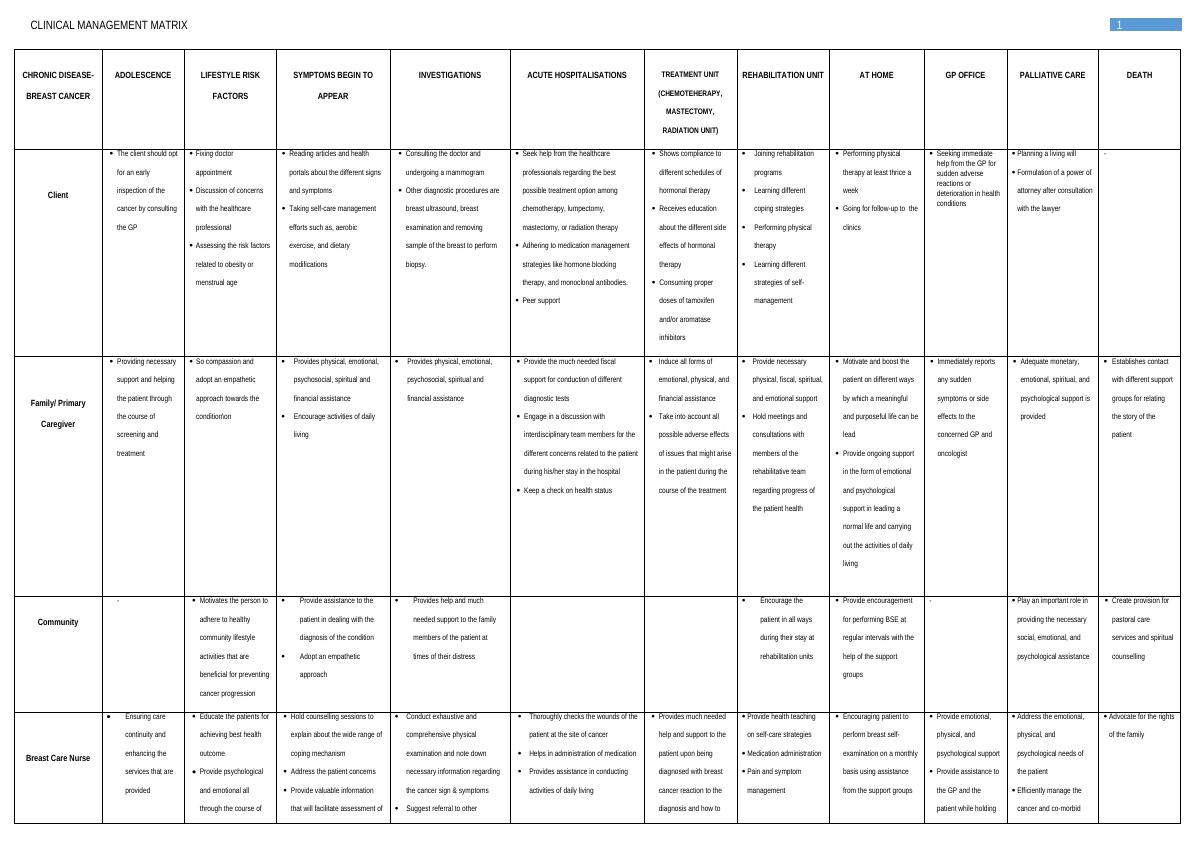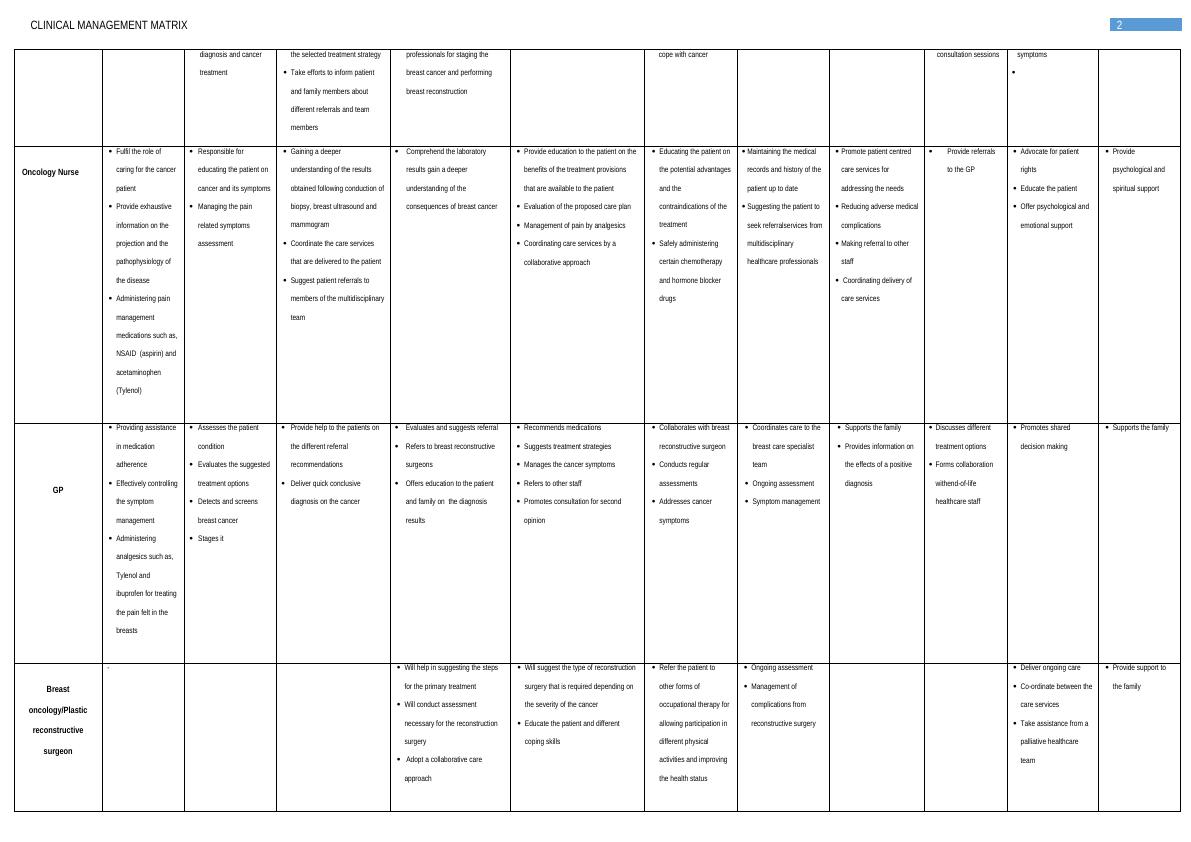Clinical Management Matrix for Breast Cancer in Adolescence
6 Pages2944 Words333 Views
Added on 2023-06-04
About This Document
This clinical management matrix provides a comprehensive guide for the management of breast cancer in adolescence. It covers lifestyle risk factors, symptoms, investigations, treatment options, and palliative care. The matrix also includes the roles of different healthcare professionals and support groups.
Clinical Management Matrix for Breast Cancer in Adolescence
Added on 2023-06-04
ShareRelated Documents
Running head: CLINICAL MANAGEMENT MATRIX
ASSESSMENT TASK 3
Name of the Student
Name of the University
Author Note
ASSESSMENT TASK 3
Name of the Student
Name of the University
Author Note

1CLINICAL MANAGEMENT MATRIX
CHRONIC DISEASE-
BREAST CANCER
ADOLESCENCE LIFESTYLE RISK
FACTORS
SYMPTOMS BEGIN TO
APPEAR
INVESTIGATIONS ACUTE HOSPITALISATIONS TREATMENT UNIT
(CHEMOTEHERAPY,
MASTECTOMY,
RADIATION UNIT)
REHABILITATION UNIT AT HOME GP OFFICE PALLIATIVE CARE DEATH
Client
The client should opt
for an early
inspection of the
cancer by consulting
the GP
Fixing doctor
appointment
Discussion of concerns
with the healthcare
professional
Assessing the risk factors
related to obesity or
menstrual age
Reading articles and health
portals about the different signs
and symptoms
Taking self-care management
efforts such as, aerobic
exercise, and dietary
modifications
Consulting the doctor and
undergoing a mammogram
Other diagnostic procedures are
breast ultrasound, breast
examination and removing
sample of the breast to perform
biopsy.
Seek help from the healthcare
professionals regarding the best
possible treatment option among
chemotherapy, lumpectomy,
mastectomy, or radiation therapy
Adhering to medication management
strategies like hormone blocking
therapy, and monoclonal antibodies.
Peer support
Shows compliance to
different schedules of
hormonal therapy
Receives education
about the different side
effects of hormonal
therapy
Consuming proper
doses of tamoxifen
and/or aromatase
inhibitors
Joining rehabilitation
programs
Learning different
coping strategies
Performing physical
therapy
Learning different
strategies of self-
management
Performing physical
therapy at least thrice a
week
Going for follow-up to the
clinics
Seeking immediate
help from the GP for
sudden adverse
reactions or
deterioration in health
conditions
Planning a living will
Formulation of a power of
attorney after consultation
with the lawyer
-
Family/ Primary
Caregiver
Providing necessary
support and helping
the patient through
the course of
screening and
treatment
So compassion and
adopt an empathetic
approach towards the
condition\on
Provides physical, emotional,
psychosocial, spiritual and
financial assistance
Encourage activities of daily
living
Provides physical, emotional,
psychosocial, spiritual and
financial assistance
Provide the much needed fiscal
support for conduction of different
diagnostic tests
Engage in a discussion with
interdisciplinary team members for the
different concerns related to the patient
during his/her stay in the hospital
Keep a check on health status
Induce all forms of
emotional, physical, and
financial assistance
Take into account all
possible adverse effects
of issues that might arise
in the patient during the
course of the treatment
Provide necessary
physical, fiscal, spiritual,
and emotional support
Hold meetings and
consultations with
members of the
rehabilitative team
regarding progress of
the patient health
Motivate and boost the
patient on different ways
by which a meaningful
and purposeful life can be
lead
Provide ongoing support
in the form of emotional
and psychological
support in leading a
normal life and carrying
out the activities of daily
living
Immediately reports
any sudden
symptoms or side
effects to the
concerned GP and
oncologist
Adequate monetary,
emotional, spiritual, and
psychological support is
provided
Establishes contact
with different support
groups for relating
the story of the
patient
Community
- Motivates the person to
adhere to healthy
community lifestyle
activities that are
beneficial for preventing
cancer progression
Provide assistance to the
patient in dealing with the
diagnosis of the condition
Adopt an empathetic
approach
Provides help and much
needed support to the family
members of the patient at
times of their distress
Encourage the
patient in all ways
during their stay at
rehabilitation units
Provide encouragement
for performing BSE at
regular intervals with the
help of the support
groups
- Play an important role in
providing the necessary
social, emotional, and
psychological assistance
Create provision for
pastoral care
services and spiritual
counselling
Breast Care Nurse
Ensuring care
continuity and
enhancing the
services that are
provided
Educate the patients for
achieving best health
outcome
Provide psychological
and emotional all
through the course of
Hold counselling sessions to
explain about the wide range of
coping mechanism
Address the patient concerns
Provide valuable information
that will facilitate assessment of
Conduct exhaustive and
comprehensive physical
examination and note down
necessary information regarding
the cancer sign & symptoms
Suggest referral to other
Thoroughly checks the wounds of the
patient at the site of cancer
Helps in administration of medication
Provides assistance in conducting
activities of daily living
Provides much needed
help and support to the
patient upon being
diagnosed with breast
cancer reaction to the
diagnosis and how to
Provide health teaching
on self-care strategies
Medication administration
Pain and symptom
management
Encouraging patient to
perform breast self-
examination on a monthly
basis using assistance
from the support groups
Provide emotional,
physical, and
psychological support
Provide assistance to
the GP and the
patient while holding
Address the emotional,
physical, and
psychological needs of
the patient
Efficiently manage the
cancer and co-morbid
Advocate for the rights
of the family
CHRONIC DISEASE-
BREAST CANCER
ADOLESCENCE LIFESTYLE RISK
FACTORS
SYMPTOMS BEGIN TO
APPEAR
INVESTIGATIONS ACUTE HOSPITALISATIONS TREATMENT UNIT
(CHEMOTEHERAPY,
MASTECTOMY,
RADIATION UNIT)
REHABILITATION UNIT AT HOME GP OFFICE PALLIATIVE CARE DEATH
Client
The client should opt
for an early
inspection of the
cancer by consulting
the GP
Fixing doctor
appointment
Discussion of concerns
with the healthcare
professional
Assessing the risk factors
related to obesity or
menstrual age
Reading articles and health
portals about the different signs
and symptoms
Taking self-care management
efforts such as, aerobic
exercise, and dietary
modifications
Consulting the doctor and
undergoing a mammogram
Other diagnostic procedures are
breast ultrasound, breast
examination and removing
sample of the breast to perform
biopsy.
Seek help from the healthcare
professionals regarding the best
possible treatment option among
chemotherapy, lumpectomy,
mastectomy, or radiation therapy
Adhering to medication management
strategies like hormone blocking
therapy, and monoclonal antibodies.
Peer support
Shows compliance to
different schedules of
hormonal therapy
Receives education
about the different side
effects of hormonal
therapy
Consuming proper
doses of tamoxifen
and/or aromatase
inhibitors
Joining rehabilitation
programs
Learning different
coping strategies
Performing physical
therapy
Learning different
strategies of self-
management
Performing physical
therapy at least thrice a
week
Going for follow-up to the
clinics
Seeking immediate
help from the GP for
sudden adverse
reactions or
deterioration in health
conditions
Planning a living will
Formulation of a power of
attorney after consultation
with the lawyer
-
Family/ Primary
Caregiver
Providing necessary
support and helping
the patient through
the course of
screening and
treatment
So compassion and
adopt an empathetic
approach towards the
condition\on
Provides physical, emotional,
psychosocial, spiritual and
financial assistance
Encourage activities of daily
living
Provides physical, emotional,
psychosocial, spiritual and
financial assistance
Provide the much needed fiscal
support for conduction of different
diagnostic tests
Engage in a discussion with
interdisciplinary team members for the
different concerns related to the patient
during his/her stay in the hospital
Keep a check on health status
Induce all forms of
emotional, physical, and
financial assistance
Take into account all
possible adverse effects
of issues that might arise
in the patient during the
course of the treatment
Provide necessary
physical, fiscal, spiritual,
and emotional support
Hold meetings and
consultations with
members of the
rehabilitative team
regarding progress of
the patient health
Motivate and boost the
patient on different ways
by which a meaningful
and purposeful life can be
lead
Provide ongoing support
in the form of emotional
and psychological
support in leading a
normal life and carrying
out the activities of daily
living
Immediately reports
any sudden
symptoms or side
effects to the
concerned GP and
oncologist
Adequate monetary,
emotional, spiritual, and
psychological support is
provided
Establishes contact
with different support
groups for relating
the story of the
patient
Community
- Motivates the person to
adhere to healthy
community lifestyle
activities that are
beneficial for preventing
cancer progression
Provide assistance to the
patient in dealing with the
diagnosis of the condition
Adopt an empathetic
approach
Provides help and much
needed support to the family
members of the patient at
times of their distress
Encourage the
patient in all ways
during their stay at
rehabilitation units
Provide encouragement
for performing BSE at
regular intervals with the
help of the support
groups
- Play an important role in
providing the necessary
social, emotional, and
psychological assistance
Create provision for
pastoral care
services and spiritual
counselling
Breast Care Nurse
Ensuring care
continuity and
enhancing the
services that are
provided
Educate the patients for
achieving best health
outcome
Provide psychological
and emotional all
through the course of
Hold counselling sessions to
explain about the wide range of
coping mechanism
Address the patient concerns
Provide valuable information
that will facilitate assessment of
Conduct exhaustive and
comprehensive physical
examination and note down
necessary information regarding
the cancer sign & symptoms
Suggest referral to other
Thoroughly checks the wounds of the
patient at the site of cancer
Helps in administration of medication
Provides assistance in conducting
activities of daily living
Provides much needed
help and support to the
patient upon being
diagnosed with breast
cancer reaction to the
diagnosis and how to
Provide health teaching
on self-care strategies
Medication administration
Pain and symptom
management
Encouraging patient to
perform breast self-
examination on a monthly
basis using assistance
from the support groups
Provide emotional,
physical, and
psychological support
Provide assistance to
the GP and the
patient while holding
Address the emotional,
physical, and
psychological needs of
the patient
Efficiently manage the
cancer and co-morbid
Advocate for the rights
of the family

2CLINICAL MANAGEMENT MATRIX
diagnosis and cancer
treatment
the selected treatment strategy
Take efforts to inform patient
and family members about
different referrals and team
members
professionals for staging the
breast cancer and performing
breast reconstruction
cope with cancer consultation sessions symptoms
Oncology Nurse
Fulfil the role of
caring for the cancer
patient
Provide exhaustive
information on the
projection and the
pathophysiology of
the disease
Administering pain
management
medications such as,
NSAID (aspirin) and
acetaminophen
(Tylenol)
Responsible for
educating the patient on
cancer and its symptoms
Managing the pain
related symptoms
assessment
Gaining a deeper
understanding of the results
obtained following conduction of
biopsy, breast ultrasound and
mammogram
Coordinate the care services
that are delivered to the patient
Suggest patient referrals to
members of the multidisciplinary
team
Comprehend the laboratory
results gain a deeper
understanding of the
consequences of breast cancer
Provide education to the patient on the
benefits of the treatment provisions
that are available to the patient
Evaluation of the proposed care plan
Management of pain by analgesics
Coordinating care services by a
collaborative approach
Educating the patient on
the potential advantages
and the
contraindications of the
treatment
Safely administering
certain chemotherapy
and hormone blocker
drugs
Maintaining the medical
records and history of the
patient up to date
Suggesting the patient to
seek referralservices from
multidisciplinary
healthcare professionals
Promote patient centred
care services for
addressing the needs
Reducing adverse medical
complications
Making referral to other
staff
Coordinating delivery of
care services
Provide referrals
to the GP
Advocate for patient
rights
Educate the patient
Offer psychological and
emotional support
Provide
psychological and
spiritual support
GP
Providing assistance
in medication
adherence
Effectively controlling
the symptom
management
Administering
analgesics such as,
Tylenol and
ibuprofen for treating
the pain felt in the
breasts
Assesses the patient
condition
Evaluates the suggested
treatment options
Detects and screens
breast cancer
Stages it
Provide help to the patients on
the different referral
recommendations
Deliver quick conclusive
diagnosis on the cancer
Evaluates and suggests referral
Refers to breast reconstructive
surgeons
Offers education to the patient
and family on the diagnosis
results
Recommends medications
Suggests treatment strategies
Manages the cancer symptoms
Refers to other staff
Promotes consultation for second
opinion
Collaborates with breast
reconstructive surgeon
Conducts regular
assessments
Addresses cancer
symptoms
Coordinates care to the
breast care specialist
team
Ongoing assessment
Symptom management
Supports the family
Provides information on
the effects of a positive
diagnosis
Discusses different
treatment options
Forms collaboration
withend-of-life
healthcare staff
Promotes shared
decision making
Supports the family
Breast
oncology/Plastic
reconstructive
surgeon
- Will help in suggesting the steps
for the primary treatment
Will conduct assessment
necessary for the reconstruction
surgery
Adopt a collaborative care
approach
Will suggest the type of reconstruction
surgery that is required depending on
the severity of the cancer
Educate the patient and different
coping skills
Refer the patient to
other forms of
occupational therapy for
allowing participation in
different physical
activities and improving
the health status
Ongoing assessment
Management of
complications from
reconstructive surgery
Deliver ongoing care
Co-ordinate between the
care services
Take assistance from a
palliative healthcare
team
Provide support to
the family
diagnosis and cancer
treatment
the selected treatment strategy
Take efforts to inform patient
and family members about
different referrals and team
members
professionals for staging the
breast cancer and performing
breast reconstruction
cope with cancer consultation sessions symptoms
Oncology Nurse
Fulfil the role of
caring for the cancer
patient
Provide exhaustive
information on the
projection and the
pathophysiology of
the disease
Administering pain
management
medications such as,
NSAID (aspirin) and
acetaminophen
(Tylenol)
Responsible for
educating the patient on
cancer and its symptoms
Managing the pain
related symptoms
assessment
Gaining a deeper
understanding of the results
obtained following conduction of
biopsy, breast ultrasound and
mammogram
Coordinate the care services
that are delivered to the patient
Suggest patient referrals to
members of the multidisciplinary
team
Comprehend the laboratory
results gain a deeper
understanding of the
consequences of breast cancer
Provide education to the patient on the
benefits of the treatment provisions
that are available to the patient
Evaluation of the proposed care plan
Management of pain by analgesics
Coordinating care services by a
collaborative approach
Educating the patient on
the potential advantages
and the
contraindications of the
treatment
Safely administering
certain chemotherapy
and hormone blocker
drugs
Maintaining the medical
records and history of the
patient up to date
Suggesting the patient to
seek referralservices from
multidisciplinary
healthcare professionals
Promote patient centred
care services for
addressing the needs
Reducing adverse medical
complications
Making referral to other
staff
Coordinating delivery of
care services
Provide referrals
to the GP
Advocate for patient
rights
Educate the patient
Offer psychological and
emotional support
Provide
psychological and
spiritual support
GP
Providing assistance
in medication
adherence
Effectively controlling
the symptom
management
Administering
analgesics such as,
Tylenol and
ibuprofen for treating
the pain felt in the
breasts
Assesses the patient
condition
Evaluates the suggested
treatment options
Detects and screens
breast cancer
Stages it
Provide help to the patients on
the different referral
recommendations
Deliver quick conclusive
diagnosis on the cancer
Evaluates and suggests referral
Refers to breast reconstructive
surgeons
Offers education to the patient
and family on the diagnosis
results
Recommends medications
Suggests treatment strategies
Manages the cancer symptoms
Refers to other staff
Promotes consultation for second
opinion
Collaborates with breast
reconstructive surgeon
Conducts regular
assessments
Addresses cancer
symptoms
Coordinates care to the
breast care specialist
team
Ongoing assessment
Symptom management
Supports the family
Provides information on
the effects of a positive
diagnosis
Discusses different
treatment options
Forms collaboration
withend-of-life
healthcare staff
Promotes shared
decision making
Supports the family
Breast
oncology/Plastic
reconstructive
surgeon
- Will help in suggesting the steps
for the primary treatment
Will conduct assessment
necessary for the reconstruction
surgery
Adopt a collaborative care
approach
Will suggest the type of reconstruction
surgery that is required depending on
the severity of the cancer
Educate the patient and different
coping skills
Refer the patient to
other forms of
occupational therapy for
allowing participation in
different physical
activities and improving
the health status
Ongoing assessment
Management of
complications from
reconstructive surgery
Deliver ongoing care
Co-ordinate between the
care services
Take assistance from a
palliative healthcare
team
Provide support to
the family

End of preview
Want to access all the pages? Upload your documents or become a member.
Related Documents
Peer Teaching in Breast Cancer Treatment and Breast Implantslg...
|8
|825
|123
Psychosocial Support of a 50 Year Old Man with Lymphoma PowerPoint Presentation 2022lg...
|10
|1160
|34
Male Breast Cancerlg...
|4
|797
|193
Case Study on Palliative Carelg...
|4
|803
|492
Improving Patient Journey and Provider Experience in Breast Cancer Carelg...
|24
|7115
|494
Breast Cancer—Patient Versionlg...
|10
|2587
|10
